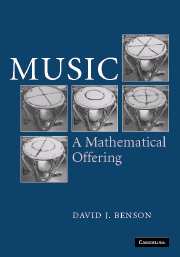Book contents
- Frontmatter
- Contents
- Preface
- Acknowledgements
- Introduction
- 1 Waves and harmonics
- 2 Fourier theory
- 3 A mathematician's guide to the orchestra
- 4 Consonance and dissonance
- 5 Scales and temperaments: the fivefold way
- 6 More scales and temperaments
- 7 Digital music
- 8 Synthesis
- 9 Symmetry in music
- Appendix A Bessel functions
- Appendix B Equal tempered scales
- Appendix C Frequency and MIDI chart
- Appendix D Intervals
- Appendix E Just, equal and meantone scales compared
- Appendix F Music theory
- Appendix G Recordings
- References
- Bibliography
- Index
3 - A mathematician's guide to the orchestra
Published online by Cambridge University Press: 05 March 2013
- Frontmatter
- Contents
- Preface
- Acknowledgements
- Introduction
- 1 Waves and harmonics
- 2 Fourier theory
- 3 A mathematician's guide to the orchestra
- 4 Consonance and dissonance
- 5 Scales and temperaments: the fivefold way
- 6 More scales and temperaments
- 7 Digital music
- 8 Synthesis
- 9 Symmetry in music
- Appendix A Bessel functions
- Appendix B Equal tempered scales
- Appendix C Frequency and MIDI chart
- Appendix D Intervals
- Appendix E Just, equal and meantone scales compared
- Appendix F Music theory
- Appendix G Recordings
- References
- Bibliography
- Index
Summary
Introduction
Ethnomusicologists classify musical instruments into five main categories, which correspond reasonably well to the mathematical description of the sound they produce.
Idiophones, where sound is produced by the body of a vibrating instrument. This category includes percussion instruments other than drums. It is divided into four subcategories: struck idiophones such as xylophones and cymbals, plucked idiophones (lamellophones) such as the mbira and the balafon, friction idiophones such as the (bowed) saw, and blown idiophones such as the aeolsklavier (a nineteenth century German instrument in which wooden rods are blown by bellows).
Membranophones, where the sound is produced by the vibration of a stretched membrane; for example, drums are membranophones. This category also has four subdivisions: struck drums, plucked drums, friction drums, and singing membranes such as the kazoo.
Chordophones, where the sound is produced by one or more vibrating strings. This category includes not only stringed instruments such as the violin and harp, but also keyboard instruments such as the piano and harpsichord.
Aerophones, where the sound is produced by a vibrating column of air. This category includes woodwind instruments such as the flute, clarinet and oboe, brass instruments such as the trombone, trumpet and French horn, and also various more exotic instruments such as the bullroarer and the conch shell.
- Type
- Chapter
- Information
- Music: A Mathematical Offering , pp. 91 - 143Publisher: Cambridge University PressPrint publication year: 2006



